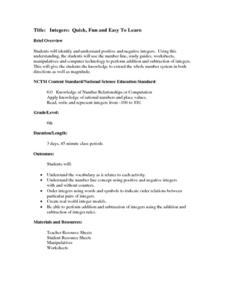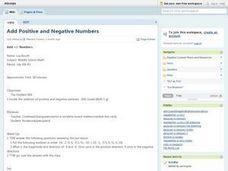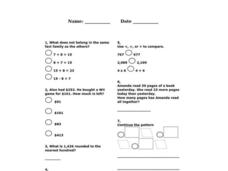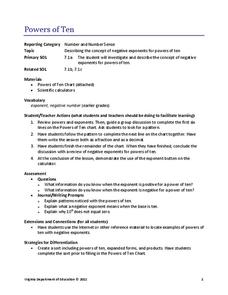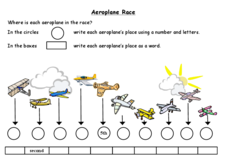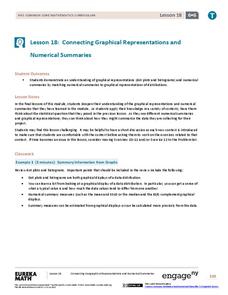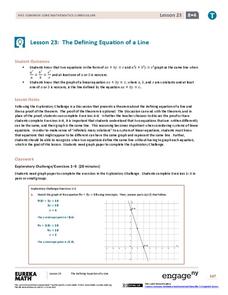Curated OER
Ten Red Apples; The Five Senses
A clever lesson designed around an apple awaits your learners. Descriptive words are used to explain what they believe is inside a bag while using their five senses. Students read the story The Apple Pie Tree and are introduced to the...
National Security Agency
Integers: Quick, Fun and Easy To Learn
A good complement to any integers unit contains a three-day lesson plan about positive and negative integers, adding and subtracting integers, and how to find the additive inverse. Additionally, it provides all necessary...
Curated OER
Singapore Math and The Common Core
Tackle The Common Core math standards with some help from your friends in Singapore.
Curated OER
Get On Board
Students create a ticket table illustrating the cost of tickets by alternative transportation. In this number sense lesson, students write number sentences to compare and contrast difference information in their chart. Students figure...
Curated OER
Add Positive And Negative Numbers
Scholars investigate the concept of adding positive and negative numbers. They practice adding using the number line for scaffolding. This can be done as a game for younger learners, but may also be helpful for engaging the older pupils.
Curated OER
Place Value
Providing a short review of place value, this activity focusing on numbers in the hundreds, could be used in a lower elementary classroom. This eight question instructional activity could be a quick and easy way to have students practice...
Curated OER
Finding Place Values
As a review of identifying the value of numbers, this worksheet would be useful. In the thirteen question activity, learners take a three digit number, and identify the value in the hundreds, tens, and ones column.
Curated OER
Math Review
In this math review worksheet, students respond to 16 questions that serve as a review of fractions, decimals, patterns, number sense, properties, story problems, and computation.
Inside Mathematics
Two Solutions
Many problems in life have more than one possible solution, and the same is true for advanced mathematics. Scholars solve seven problems that all have at least two solutions. Then three higher-level thinking questions challenge them to...
Curated OER
Who wants to win millions: Subtraction Edition
Solve subtraction problems like a pro. This Jeopardy style math review asks the class to subtract 2 digit numbers, to get to zero, to balance and equation, and to make new numbers. This is an excellent review that covers topics...
Curated OER
Who Wants to Win Millions: Counting
Have your learners review counting skills using this motivating game. Using enticing visuals, they identify the number of items displayed. This would make a terrific center activity.
Curated OER
Jeopardy Math Review
Students play a Jeopardy type game to review math concepts. They review five topics: Number Sense, Fractions and Whole Numbers, Geometry and Measurement, Decimals and Percents, and Algebraic Thinking.
Curated OER
Who Wants to Be a Champion: Number Sense
Review some common second grade concepts using this resource. Learners practice writing numbers in different forms, identify odd and even numbers, skip count, and work with Roman Numerals. The review is in the form of an Olympic...
Curated OER
Number Tick Tack Toe
Pupils practice basic addition and subtraction facts to twelve. They use high level thinking skills to win at the game of tick tack toe. Students review the rules to the game. They use strategy skills to master the game.
Virginia Department of Education
Powers of Ten
Investigate negative exponents of-ten. Pupils use the pattern of increasing powers of 10 to determine negative powers of 10. The scholars write the powers in expanded and product forms and make the connection to exponents using a...
Statistics Education Web
I Always Feel Like Somebody's Watching Me
Future statisticians and potential psychics first conduct an experiment to collect data on whether a person can tell if someone is staring at them. Statistical methods, such as hypothesis testing, chi-square tests, binomial tests, and...
Scholastic
Study Jams! Prime Factorization
Deepen the number sense of young mathematicians by exploring the process of prime factorization. Follow along with this step-by-step presentation that explains how factor trees are used to break a composite number down into its prime...
Curated OER
Aeroplane Race
Review ordinal numbers using this worksheet. Learners identify the position of a series of airplanes using ordinal numbers. This is a quick and easy way to review this concept.
Virginia Department of Education
Modeling Division of Fractions
Provide a meaningful context for learning about the division of fractions with this upper-elementary math lesson. Presented with a simple, real-world problem, young mathematicians work in small groups to develop visual models...
Charleston School District
Contextualizing Function Qualities
Let the graph tell the story! Adding context to graphs allows learners to analyze the key features of the function. They make conclusions about the situation based on the areas the graph is increasing, decreasing, or has a maximum...
EngageNY
Connecting Graphical Representations and Numerical Summaries
Which graph belongs to which summary statistics? Class members build upon their knowledge of data displays and numerical summaries to connect the two. Pupils make connections between different graphical displays of the same data in...
EngageNY
End-of-Module Assessment Task: Grade 8 Module 6
Test your knowledge of linear functions and models. The last installment of a 16-part module is an end-of-module assessment task. Pupils solve multi-part problems on bivariate data based on real-world situations to review concepts from...
Curated OER
Word Problems Review Sheet
Word problems can make even expert mathematicians go blank. Practice solving word problems with an extended version of the GUESS method (givens, unknowns, equations, solve, substitute), which adds the steps of drawing a diagram, making...
EngageNY
The Defining Equation of a Line
They appear to be different, yet they are the same line. Part 24 out of 33 lessons provides a theorem about the relationships of coefficients of equivalent linear equations. Pupils use the theorem to determine whether two equations are...

